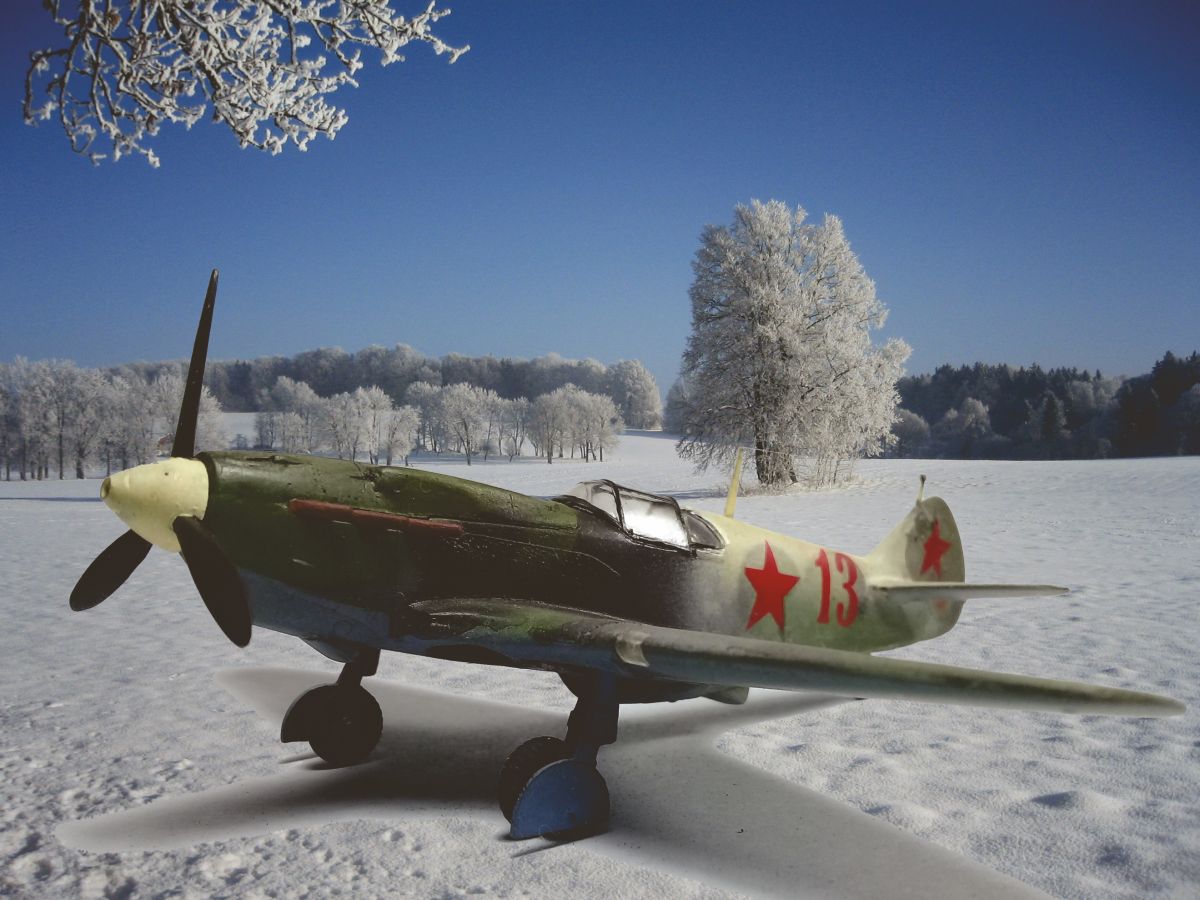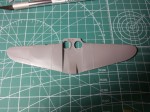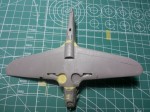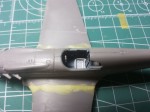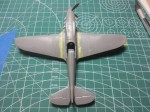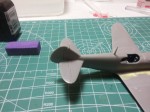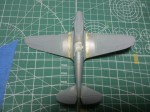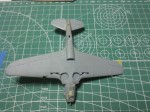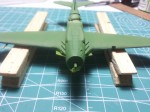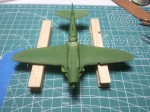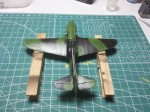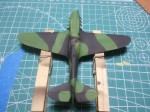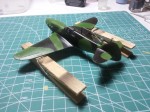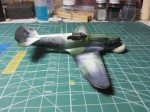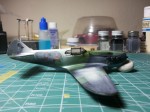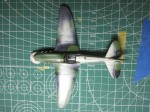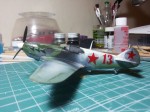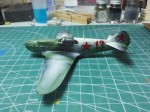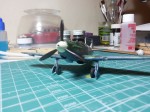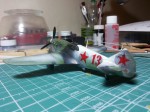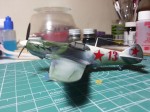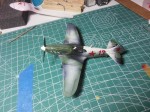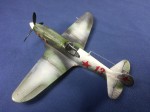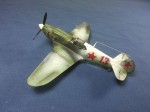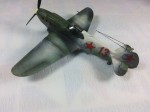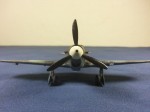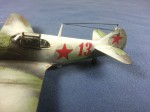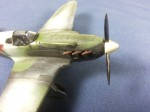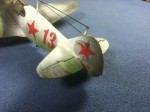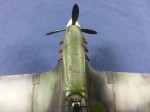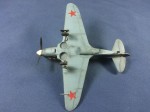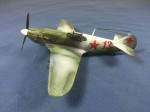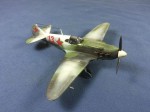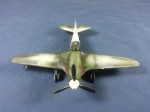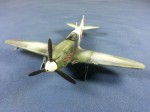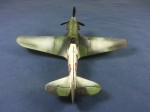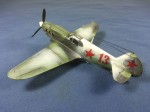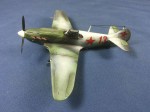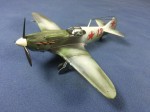1⁄72LaGG-3 35 Series Build
Introduction
This is one model I completed some time ago, but only now I found enough time to tell its story.My little adventure with this model started after Iíve read a book from Aircraft in Action series. I was impressed with the colorful Russian distemper camouflage and I had to try it out. So, I bought the only LaGG 3 available by my supplier at the time Ė the Rodenís one. I even rejoiced when Iíve seen the price: the item was on sale and the price was around $ 5.00.
Upon receiving the kit, I found the box art very attractive Ė I still consider it a piece of authentic art. What is inside the box, itís another kind of art Ė postmodernist contemporary one.
The kit
I donít feel entirely confortable to talk about the kit without any pictures. At the time I thought Iíll never get thru with this build and I didnít bother to take any. You have to take my word on this: itís the worst kit I ever ran into. It has it all: loads of flash, sink marks, no locator pins, warped parts, blobs of plastic for details, poor surface scribing, and alchemistic instructions. The worst were the halves of the fuselage: different thickness and the starboard one was so bent that when joining one end the other was forming a 45 degrees opening!The build
I started the build joining the upper halves of the wings over the lower one piece ones. I have to admit this was a mistake on my side. I should wait for the fuselage to be ready and then to minimize the gaps as much as possible, but gluing the fuselage was a two days job.The fuselage halves were glued first at the tail and let overnight to set. Next day I applied large amounts of Testors cement over the both sides to soften the plastic and forced the halves together. Even so, the fuselage never got straight. You still can see a small twist to the right on the completed model. I just couldnít figure out how to solve this problem.
When I fitted the fuselage with the wings I realized my earlier mistake, but it was too late. I braced myself for hours of sanding. Every joint was a gap Ė even at the bottom of one of the wheel wells I had to apply a Ďpancakeí of Miliput, to straighten it out.
The cockpit is rudimentary represented and I did nothing to improve it, because the canopy is not that clear either.
There is no such luxury as tail antenna mas, so I had to scratch build one. That wasnít big deal, right!
Painting, markings and weathering
I primed the entire model with Testors grey primer, just to discover that I wasnít quite done with the sanding, so I went two steps back again! After more filling and sanding, I was eventually content and re-applied Testors.I painted the aircraftís belly with a home brewed blue acrylic which I actually liked and I saved the recipe for later use.
The upper area was sprayed with Homefront forest green acrylic, and then mottled lightly with a mix of forest green and yellow. Further on, I masked the surface with blobs and strings of UHU tac, without paying too much attention to the pattern, because I planned to cover everything with winter camouflage. I covered everything with Pledge and I applied the decals. Well, as you already guessed, the decals werenít good either. They had a strong shine to them. They went nicely on, but when I tried to spray the protective gloss coat, one just flew away! Their adhesive was long gone. I lost the others when I partially removed the winter camouflage. I changed tactics for bottom side: I softened the decals with warm water, but I glued them in place with Pledge, applied straight with a brush. Those are in place still.
Next I applied a coat of highly diluted Homefront ivory white from afar, looking to achieve that grainy look caused by paint drying in the air. That paint coat dried almost instantly and I began rubbing it right away with a dump sponge to simulate a worn out winter camouflage. Against all odds, the result was good enough. I cut masks for the red stars and I traded no. 10 for no. 13 (the lucky one, yes!) For weathering I choose to use pigments and I applied also a light wash on the lower sides of the aircraft and around the engine. Unfortunately, the scribing is so poor that the wash had nothing to cling on. Because the aircraft was built in carpenterís shops, I couldnít apply metallic chipping effects. I tried to make some brown spots to imitate wood, but I wasnít charmed with the result and decided that I have reached already the bottom of my skills bag.
Conclusions
Honestly, the kit is bad, very bad. If anyone wants to build it, it has to have almost bottomless patience and terrific skill. Iím not saying now that Iím a skilled modeler Ė Iíve seen very recently on YT somebodyís build which is far beyond and above of what I managed to do. I believe the guy spent his best years working on that model Ė he basically scratch-built all exterior detail and much more.I have to say that, somehow, Iíve got attached to this little Quasimodo. When I did ďthe big clearanceĒ some months ago, it was one of the very few models that didnít end into the trash can. I canít tell you why, but itís still here, watching me as Iím writing this little story.
Copyright ©2021 by Gabriel. Images also by copyright holder unless otherwise noted. The views and opinions expressed herein are solely the views and opinions of the authors and/or contributors to this Web site and do not necessarily represent the views and/or opinions of AeroScale, KitMaker Network, or Silver Star Enterrpises. Images also by copyright holder unless otherwise noted. Opinions expressed are those of the author(s) and not necessarily those of AeroScale. All rights reserved. Originally published on: 2017-08-23 00:00:00. Unique Reads: 10646




